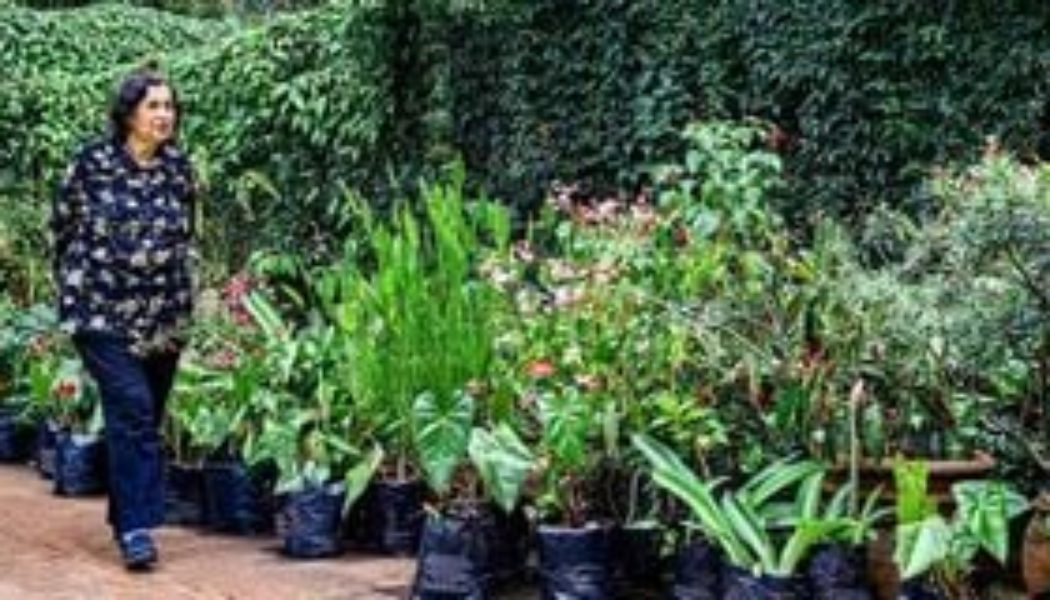The scent of dew filled the air as the gate to Leena Rao’s home in Muthaiga, Nairobi opened. I have never known how to describe the smell, but I have always recognised its source.
Surrounded by trees that are much older than she is, along with flowers that resemble the colours of the rainbow — orange, pink, purple, yellow, and green — there is green everywhere; green Paspalum grass stretching across the lower garden and an abundance of greens in the herb garden.
Mrs Rao has a green thumb. Her garden blossoms with flowers and trees she planted over two decades ago.
“I am 82 years old,” she says. But she looks like she is her 60s.
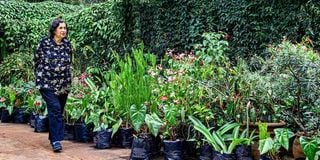
Leena Rao at a floral garden at her home in Muthaiga, Nairobi on August 15, 2024
Photo credit: Wilfred Nyangaresi | Nation
For 22 years, she has found solace in transforming what was once a wooded environment into a peaceful green oasis, where one would be happy to pay to experience the beautiful ambience of her home.
“I got married in 1963 and moved to Kenya in 1964. We lived in Muguga Green. In 1970, we bought this house and rented it out to World Bank staff. In 1972, we moved to Muthaiga and stayed in a rented flat,” says Mrs Rao.
But why live in an apartment when you have your own home?
“The World Bank staff used to stay here, and they pleaded with us to let them stay in the house because they liked it so much,” she says.
“In 1984 we moved to Holland after my husband got a job there. I liked it so much that I decided I didn’t want to leave. We ended up staying for 12 years until my husband expressed his longing for Nairobi and we returned home,” she says.
Mrs Rao’s journey to green her Muthaiga home began in 2002 after the World Bank staff left.
“I couldn’t rent it out any more. The place was overgrown, it was like a forest. So I cleared it all away. Since my grandchildren come every Christmas, I decided to make it nice,” she says.
But she did not start planting flowers out of the blue.
“I have loved gardening since I was a child. When I was nine years old, I used to collect seeds and put them in a bottle, not realising that they would die. Collecting was my main thing,” she says.
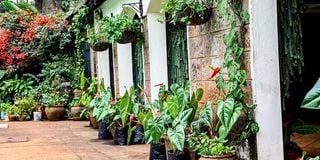
Leena Rao’s home in Muthaiga, Nairobi covered with different species of flowers on August 15, 2024.
Photo credit: Wilfred Nyangaresi | Nation
Her favourite
Our tour begins in the front garden. Right at the entrance to her 1940s house are blooming anthuriums in red and yellow. This is her favourite plant, and she has grown many in pots and on the ground.
“They last longer, they are very hardy. They are also competitive. They survive a lot of competition,” she says.
Something caught my eye. The anthuriums planted at the entrance are taller than those in the main garden.
Music and talk therapy
“People stand and talk at the door, and we like to sit here too (she points to a gazebo just three steps from the door). When you play music and there are plants around, they grow bigger,” she says.
I find that funny, but she has been a plant lover for many decades, and she believes it.
In the courtyard, she has transformed an old chapel into a beautiful, museum-like setting. Long before the Raos bought the property, it was used by an Irish priest. Now she has turned it into a guest house.
Her gardening skills are evident here, from Heliconias to Lylis. The area is breathtaking.
The staghorn fern thrives in the green. This is an epiphytic plant, which means it grows on other plants or objects for support but is not parasitic. It is known for its deer-like shape.
Thunbergia mysorensis, also known as Mysore trumpet vine or Indian clock vine, creeps across the ceiling in red and purple.
“I bought this in Uganda. You won’t find it here. The only thing is that it needs a lot of water,” says Ms Rao.
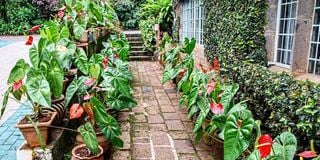
A view of Leena Rao’s residential home in Muthaiga, Nairobi covered with different species of flowers on August 15, 2024.
Photo credit: Wilfred Nyangaresi | Nation
The room is also home to the old man’s beard, the elephant’s ears, the donkey’s tail, palms, the money plant and the Christmas plant.
Her children
“I call them my children and I don’t let anyone cut them,” says the mother of two.
In another garden, just below the old chapel, the bougainvillaea competes with the neem tree, the mwarubaine. Birds of paradise are in bloom
Along the path to the entrance of the house, the geraniums, in a variety of colours, are perfectly arranged in pots, creating a welcoming atmosphere.
There used to be a 200-year-old tree in the middle of the path, which she had to cut down, and not just to make way for a walkway.
“My daughter said we were getting old and we needed to make a path for an ambulance. So we had to clear it out for the ambulance,” she says with a chuckle.
Her activity garden, set beneath a manicured Zimbabwean lawn, entertains up to 30 dinner guests.
The ones that died
From pots to sacks, bottles and containers, Mrs Rao has thousands of plants. She buys them mainly from street vendors and nurseries.
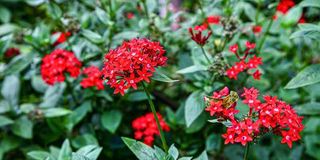
Egyptian Star Cluster at Leena Rao’s home in Muthaiga, Nairobi on August 15, 2024.
Photo credit: Wilfred Nyangaresi | Nation
Mrs Rao has, however, overcome challenges to create such a beautiful garden. Of the plants she has, 50 percent have died. She says that gardening is not just about planting and watering.
She also tried planting orchids, which her husband, Sharad Rao loved, but they all died.
“The orchids need a lot of care, which I didn’t have, so they all died and I gave up,” she says.
“I used to spend a lot of money on plants. I used to buy every plant I came across, but some of them never survive unless you look after them closely, I can’t do that. I like stable plants, that survive, and we travel a lot. Now I just spend money on fertiliser.”
She also encounters pests and diseases, but chemical sprays have always worked for her plants.
The ‘monkey business’
Despite the completion of the ecosystem, the monkeys cannot leave her alone. Jumping from plant to plant and destroying them is a problem that her gardeners, Patrick Kanga and Moses Shanzu, who have been looking after her garden for 20 years, have to deal with daily. They also make sure the garden is watered twice a week.
With the beautiful flowers, the birds are always guests in her garden. But once again, the squirrels will not let them have a peaceful birth.
Through all the challenges of her journey, the garden has given her a lot of peace.
With over eight decades around the sun, Mrs Rao could take us on a tour of her two-acre garden and talk at the same time.
A former school teacher, Mrs Rao also finds solace in painting and sewing.
“When you like something, it calms you down. When my head is not right, I just walk around the garden and admire how beautiful it is,” she says.
“Flowers are like people, they need to be controlled. You have to feed them. If you talk to them, they are happy,” says the grandmother of five.
